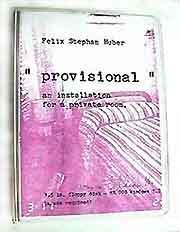-----------------[F.S.H. Home]
[Projects]
[Biografie]
[Texts]
[provisional]
p r o v i s i o n a l 1993
an Installation for a private room


|
A growing part of our time as consumers is geing devoted to television, radio and print news.
We experience the news from around the world as passive recipients, unable to participate.
The world of the news touches our personal live less and less.
An urgent exemple is world wide migration. through war, hunger and economic misery, millions
people are being left wandering around. Daily the media displays images of emergency housing,
people sitting or sleeping on a bed, the smallest private area they are given - temporalily.
Just two square meters belongs to everyone. Less space would be below the threshold set by the
western world - at least officially. The reality drawn by the media is seperated by a feeling
of powerlessness and fear from our own reality, our own space, where we get up every morning.
The installation "provisional" brings these worlds together. This program will ask you foer
the dimensions of a room in your home and to place furniture in it as it exists.
This drawing will be printed out with one that the computer proposes, confronting you with
these two realities side by side.
|
PROVISIONAL an essay by Gregory Volk
1.
In Felix Stefan Huber's interactive computer program Provisional, a series of
easily understood prompts invites one to design on the screen a convincing
floor plan of one's bedroom. After the approximate dimensions and shape of
the room have been determined, one selects from a list of likely furniture,
including bed, desk, bookshelves, windows, table and chairs, represented by
simple icons. By clicking and dragging these icons to their appropriate
locations, one becomes an impromptu interior designer, not, however, of a
hypothetical or ideal room (although there is something about the power and
license of a computer that automatically makes one want to become an imaginary
millionaire and design a phantasmagorical dream room which is far larger and
more wonderful than any place one has ever lived in one's life) but of the
most private and personal of spaces that one inhabits on a daily basis, and
has, perhaps, for years.
The resulting diagram (and there will ultimately be hundreds of such
diagrams, since hundreds of people will participate) is spare, pristine, and
abstract. As if from a great distance, with a sort of horizontal bird's eye
view, one sees beyond the clutter and accumulation in one's room into its pure
architectural order, its logic and pattern, its map. And this gives one a
brief feeling of mastery, of discovery. In this democratized, do-it-yourself
design program it is not only the far-away rooms of the rich, or the powerful,
or the socially prominent, or the famous that warrant such treatment, it is
also one's own little room, one's private enclave, one's home. Unlike most
floor plans, however, which have as their central impetus an appeal to a new
and improved future, the ones generated by this program focus on the immediate
present, and on the past.
2.
Yet the map is only a sketch, an approximation. It is not "real," as far as
floor-plans are concerned, for there are no measurements and there is no
precision, and it is based entirely on memory, not on anything objective. And
while (if one is fastidious) the diagram may function as an approximate
physical description of one's room, it also functions as a mask in that it
conceals not only the innumerable individual touches, talismanic knick-knacks,
and non-standard features that give such a room its aura of familiarity but
also the great host of psychological and experiential forces that have
everything to do with how one lives in that room.
As one gets nearer and nearer to the room's central layout, exactly what is
concealed behind this mask of a floor plan becomes more and more unsteadying.
For in recalling the layout of one's bedrooma room characterized by the
rhythms of waking and sleeping; by reading, dreaming, daydreaming, and sexual
intimacy; that "corner of the world" (to borrow Gaston Bachelard's phrase)
where one is both supremely alone and exultantly communal; in short the most
intimate and psychologically volatile of all the rooms one inhabitsone is
confronted with a plenitude of both tumultuous and seemingly insignificant
memories that have no outlet, given the terms of the program. The diagram of
the bedroom, therefore, cannot possibly describe the room's subjective,
memory-encrusted importance. This occurs privately and silently, outside the
margins; beyond the computer screen and outside the program.
Near the beginning of his influential treatise, The Poetics of Space,
Bachelard suggests that in order to get at a meaningful interpretation of
architectural space (especially when it comes to the home) we must move beyond
physical description, however accurate or poetic, to a comprehensive
invocation that includes a phenomenology of how one lives in that space. In
Provisional, a supremely minimal descriptiona generic floor planinvokes such
a phenomenology yet it does so obliquely and indirectly; it is present, yet
hidden; potent yet entirely invisible. One looks at one's own diagram with a
fresh reappraisal of the daily activity in that room (of oneself in that
room), and one looks at the diagrams made by others with a fresh and alert
curiosity. The diagrams become metaphors for an implicit activity. In much
the same way that the tidy, succinct, concise, and relentlessly accurate zone
of the computer screen on which a simulated room appears conceals all of the
historical mayhem (cracked paint, unlevel floors, radiators in sore need of
cleaning) that otherwise contributes so decisively to the aura of the actual
room, the program itself, which limits one to the arrangement and manipulation
of shapes, conceals what one actually does with that furniture, what one sees
through those windows, what one dreams in that bed, with whom that bed is
occasionally shared.
As a result, the diagram begins to feel like a confession, although it
remains entirely unclear exactly what is being confessed.
3.
As a computer program, Provisional is spare, austere, utilitarian and bluntly
pragmatic. It is not chock-full of intricate wonders and it requires no real
expertise. In every way it resists the technological seductions which we have
come to associate with the information age, or with computer-based art for
that matter, and while it uses the forum of the computer it is in no way
conceived as another form of homage to the computer's omnipotence. It uses
the computer as a tool; it is not devoted to the computer. In its frankly
minimal approach to software it contributes to a shift in focus from the
computer itself (its amazing abilities, its extravagant capacities, the access
it provides us to the fresh transcendence of global cyberspace) to the actual,
and highly subjective, memory of the operator. It is a program that
emphasizes not mechanical but human memory.
4.
When everything has been correctly arranged, when the bed is in its proper
location as are the desk and the bookshelves and the table and the chairs;
when one sits facing a diagram of the room in which one woke up in the morning
and will return to later that night (and there is some wonder in launching a
map of this private zone out into the arena of digital space), the program
then automatically takes this painstakingly-realized layout and in a matter of
half a second recasts the room as a shelter: an urban shelter, perhaps, the
kind populated by refugees, by victims of domestic violence, or by the
homeless. The same kind that otherwise upstanding property owners agitate
against vociferously (they don't want their pure, familiar neighborhood
invaded by that sort of people, while those people might very well be in
need, they should look elsewhere for assistance). The kind into which gangs
of children, emboldened by patriotic fantasies, have occasionally tossed
firebombs.
As many beds as can fit are whisked into rows with a utilitarian and
relentless precision; they displace the desk that one purchased, perhaps, from
a second-hand shop and the favorite table that one found on the street. One
sees with some alarm that one's room could, merely could, function as, say, a
resting place for three families from Sarajevo or for nine or ten homeless
people. In half a second this entire subjective aura, what I have done there,
what I have done with others, all of this personal gravity in a space
colonized by me, disappears, and my space, my room, as a functioning private
locale is set side by side with the room in which the Other lives, in this
sense the most marginal and vulnerable of others. Merely by a dialogue of
shapes one is forced to confront one of the most durable problems of this age.
One's own private room becomes shadowed by its societal double; it loses its
status as a personal zone of refuge and retreat and instead becomes implicated
in the seethe and movement of peoples. Behind the screen, somehow beyond the
screen, this room is invaded by, for want of a better term, reality, and
especially by a reality that most of us have only a tangential relationship to
at best.
It is with some alarm that one realizes that while one has read countless
newspaper articles about shelters, and while the great cities are increasingly
clogged with the homeless, and while immigrants and refugees tap on the doors
of the wealthy societies asking for a very modest succor, for a small portion
of what the citizens of those societies consider to be a birthrightnamely a
home, some shelter, warmth, a bedone has in all likelihood never actually
been inside such a shelter, in which the allocation of space is approached not
on a psychological or aesthetic basis but on a completely pragmatic one: in
which the question is, how many beds might fit in a given space, not how one
bed should be arranged in relation to the other furniture in order to assure
maximum personal comfort.
5.
Both diagramsone's bedroom as a centrally private zone and as an
instantaneous shelterare then printed out in order to be displayed as "art
works," which may, and probably should, be hung on a wall in one's actual
bedroom thus leading to a vigorous exchange between the computer-generated
simulation and the blunt, intensely physical, fact. The art work in this case
is not something made by an artist for an audience but is rather an accrual of
memories based on an alliance of contributors, in which the normal roles,
rules, and hierarchies within the "art world" are temporarily suspended. One
cannot with all clarity say exactly who the artist is (Huber? the software
designer? the participants?) nor who the dealer is, nor the collector, nor the
audience. Roles become temporarily fluid, uncharted and unfixed, especially
so when the program becomes fully operative as a network. In Provisional,
what is private become unsteady and what is public becomes uncertain; out of
this reappraisal, this condition of questing, which only occurs as a dialogue
of evocative shapes via the computer, the program's "meaning" assembles.
Gregory Volk

